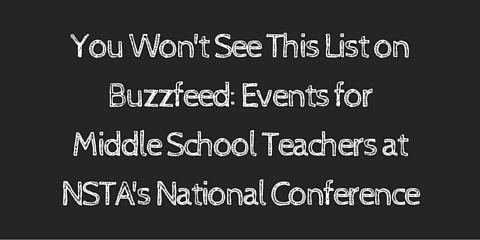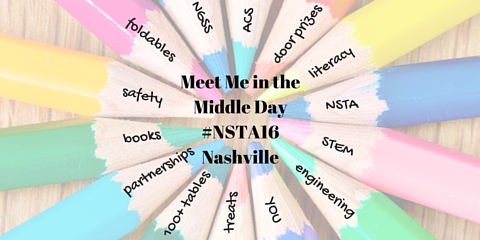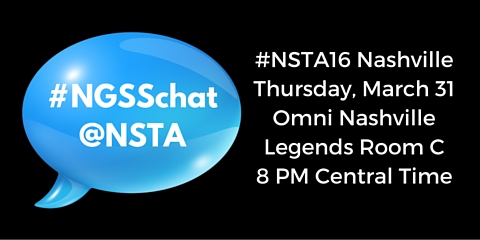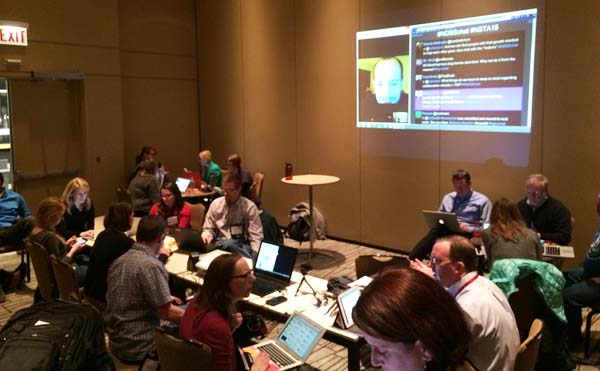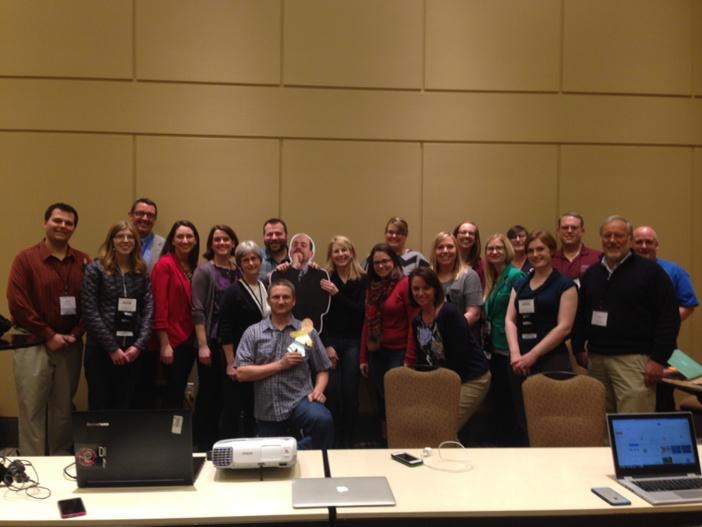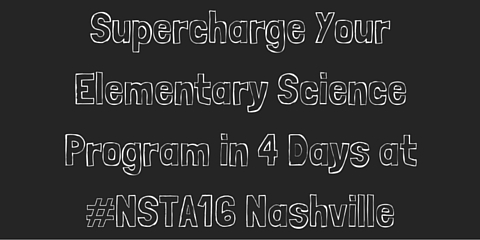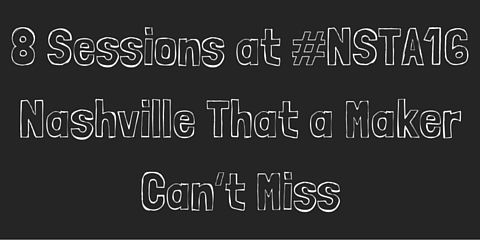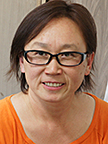Ideas and information from NSTA's March K-12 journals
By Mary Bigelow
Posted on 2016-03-13
This month, all three K-12 journals include What We Call Misconceptions May Be Necessary Stepping-Stones Toward Making Sense of the World (a must-read) and Outstanding Science Trade Books for Students K–12 (a must-share).
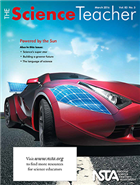 The Science Teacher – Powered by the Sun
The Science Teacher – Powered by the Sun
Most of the lessons in TST include a detailed chart connecting the lesson to the NGSS.
- Science’s Super Star is not about celestial bodies—but the starlet sea anemone. The article describes how to culture these organisms in the classroom and the types of research students can conduct on their reproduction, growth and development, regeneration, and reactions to stimuli.
- Does It Mix? Introduces students to the concepts of hydrophilic and hydrophobic molecules.
- Building a Greener Future connects engineering and science in a project to design, construct, and test compost bins for a community garden.
- Science 2.0: Mastering Scientific Practices With Technology, Part 2 recommends technology tools that support the NGSS science and engineering practices of analyzing and interpreting data, using mathematics and computational thinking, and constructing explanations and designing solutions.
- Idea Bank: Using Earthquakes as “Teachable Moments” has a source of real-time information and data on earthquakes (the presentations are also available in Spanish). There are three entries to date for 2016. http://www.iris.edu/hq/retm/
- Powered by the Sun includes many photographs of an engineering challenge in which students designed, built, and tested solar-powered vehicles (with electric motors, solar cells, gears, and wheels).
For more on the content that provides a context for these projects and strategies see the SciLinks topics Cnidarians, Emulsions, Forces and Motion, Graphing Data, Math and Science, Measurements and Data, Solar Energy, Solubility, Solutions.
Continue for Science and Children and Science Scope.
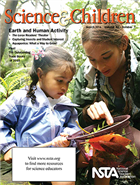 Science and Children- Earth and Human Activity
Science and Children- Earth and Human Activity
Spring is a perfect time for the featured lessons here on the connections between human behavior and the environment. Most of the lessons include a detailed chart connecting the lesson to the NGSS.
- The Lorax Readers’ Theater has an example of how to integrate literature and science, using a popular book.
- Capturing Insects and Student Interest builds on the interest students have in carnivorous plants through investigating, learning centers, and creating illustrated descriptions.
- Students explore sustainability in Aquaponics: What a Way to Grow! by designing and building aquaponic systems. The article has photos of the results of this 5E lesson.
- Understanding Human Impact is the focus of a lesson in which students learn about watersheds and the effect of human activity on the living things and the quality of the environment.
- Students take the role of marine biologist in the 5E lesson Crabby Interactions to study the impact of human activity on the blue crab and its environment.
- Teaching Through Trade Books: Humans and the Earth includes two lessons that trace objects to their origins (K-2) and study the impacts of natural disasters, specifically earthquakes (3-5). Trade books also are the basis for activities in Engineering Encounters: The Cat in the Hat Builds Satellites
- The Early Years: Composting With Children shows how young scientists can explore how materials decompose and how composting recycles these materials.
- Formative Assessment Probes: Is It Erosion or Weathering? explores differences between these two concepts that students may think are the same.
For more on the content that provides a context for these projects and strategies see the SciLinks topics Adaptations of Plants, Aquatic Plants and Animals, Arthropods, Composting, Decomposers, Deposition, Earthquakes, Earthquakes and Society, Erosion, Hydroponics, Natural Resources, Stream Deposition, Water Erosion, Watersheds, Weathering and Erosion, Wind Erosion.
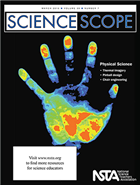 Science Scope – Physical Science
Science Scope – Physical Science
From new elements to engineering designs to technology enhancements, physical science and its applications are interesting to students (and teachers). Most of the lessons include a detailed chart connecting the lesson to the NGSS.
- Exposing Hidden Energy Transfer With Inexpensive Thermal Imaging Cameras uses this technology to help students understand and capture images of “missing” energy.
- If your students are new to problem-based learning, Chemical Connections: A Problem-Based Learning, STEM Experience provides a step-by-step example and advice that could apply to a variety of subject areas.
- Pinball Wizards illustrates a project in which students collaborated on designing and constructing a mechanical pinball machine,
- In another design project, Build Your Own Sunglasses, students apply what they’ve learned about light and UV radiation to design eye protection.
- Everyday Engineering: Sitting Around Designing Chairs presents a 5E lesson that challenges students do design a structure made of paper that will support their weights.
- Add some sparks to your unit on electricity with Tried and True: Measuring Static Electricity: A Classroom Investigation to Understand the Triboelectric Series.
- Take your students to a interdisciplinary level with Teacher’s Toolkit: A Framework for Cross-Disciplinary Engineering Projects with ideas for designing marble ramps and marshmallow towers.
For more on the content that provides a context for these projects and strategies see the SciLinks topics Forces and Motion, Heat Energy, Radiation from the Sun, Simple Machines, Static Electricity, Transfer of Energy, UV Index.
This month, all three K-12 journals include What We Call Misconceptions May Be Necessary Stepping-Stones Toward Making Sense of the World (a must-read) and Outstanding Science Trade Books for Students K–12 (a must-share).
You Won't See This List on Buzzfeed: Events for Middle School Teachers at NSTA's National Conference
By Lauren Jonas, NSTA Assistant Executive Director
Posted on 2016-03-13
If you teach middle school science, you need to be in Nashville for the NSTA National Conference on Science Education, March 31–April 3. You’ll be with thousands of your fellow teachers for the week and take home tried-and-true strategies for everything from creating maker spaces to breaking down lessons for diverse communities of learners. There will be an entire day devoted to middle school teachers and hundreds of other sessions throughout the rest of the conference. Teach your students about circuits and electricity with Sewing Science: Using Electronic Textiles Technology to Teach Electricity and Circuits or face the Zombie Apocalypse session to learn more about how disease spreads using simulations and models. We have something for every middle school teacher, no matter if you’re just starting out or been at the job for years. Check out the events below to get a sense of what we’ve got in store, and browse all the sessions here (more than 1000 of them!) to see all that we have to offer.
Meet Me in the Middle Day
Saturday, April 2 10:15 AM–4:00 PM| Omni Nashville Hotel
- The day’s events will include a networking session, more than a dozen presentations specifically for middle school educators, and an afternoon share-a-thon featuring more than 100 presenters. You’ll walk away with ideas you can put to use in your classroom next week! [Organized by the National Middle Level Science Teachers Association (NMLSTA) and sponsored by Carolina Biological Supply, PASCO scientific, and Texas Instruments]
Middle School Science with Vernier
- Use Vernier sensors, including our Go Wireless sensors, to conduct a variety of age-appropriate experiments in this engaging, hands-on workshop. Experience data collection using LabQuest 2, Logger Pro computer software, Chromebook, and mobile devices. Explore the wide range of tools from Vernier that promote understanding of middle school science concepts.
Sewing Science: Using Electronic Textiles Technology to Teach Electricity and Circuits
- Learn how to engage students in circuits and electricity though sewing! Research shows how electronic textiles are an effective way to engage girls and others in science.
Bumpers Save Lives
- In this hands-on and very active session, experience the science behind the materials selected for car bumpers. Apply those concepts to engineer a car bumper. Bumpers will be tested and analyzed to determine the best design solution. Take home CD of lesson plans and resources.
Zombie Apocalypse!
- Become part of a zombie apocalypse as brains will be served (while supplies last). Learn about disease spread modeling using simulations and fun storylines about a zombie outbreak. Applicable for middle school and high school, this workshop is sure to scare you and your little zombies into learning how exciting Hollywood themes can be used to teach science concepts.
Amplify Science for Grades 6–8: Experience Three-Dimensional Teaching and Learning with the Newest Curriculum from The Lawrence Hall of Science
- Experience our field-tested, technology-enhanced, 100% NGSS-designed K–8 curriculum. Built around argumentation, digital simulations, modeling tools, hands-on investigations, and explicit disciplinary literacy instruction, Amplify Science engages students with deep dives into understanding the natural and designed worlds. Focusing on middle school, this workshop provides a sneak peek.
Modeling Energy Flow in Ecosystems: Developing Models in Middle School Life Science
- How is matter conserved, and how does energy flow through an ecosystem? Develop these models through hands-on activities. Take home a set of student materials, overview instructional strategies for scientific practices, and preview online activities and NGSS connections in the newly revised FOSS Populations and Ecosystems Course for middle school.
Meet Me in the Middle Session: Use Science to Support and Develop ELL Language Acquisition
- The NGSS supports science learning for all students. We will focus on English language learners and the language support and discourse strategies that engage all students regardless of their English proficiency. Activities will be geared toward developing a classroom culture that ensures that all student voices are included and respected. Take home engaging lessons.
Register to attend #NSTA16 Nashville here—and don’t forget, NSTA members get a substantial discount!
The mission of NSTA is to promote excellence and innovation in science teaching and learning for all.
Future NSTA Conferences
2016 National Conference
2016 STEM Forum & Expo
2016 Area Conferences
Follow NSTA
• hands-on science activities with engaging titles such as “Mountain Mayhem,” “Oceans on the Move,” and “Trash Soup”;
• readings that cover important Earth science concepts and support the Next Generation Science Standards;
• hands-on science activities with engaging titles such as “Mountain Mayhem,” “Oceans on the Move,” and “Trash Soup”;
• readings that cover important Earth science concepts and support the Next Generation Science Standards;
#NGSSchat at #NSTA16 | Building PLNs 140 Characters at a Time
By Guest Blogger
Posted on 2016-03-12
#NGSSchat is coming to Nashville, as part of the NSTA National Conference on Science Education! Join us Thursday, March 31, at the Omni Nashville in the Legends C room at 8 Central Time, or virtually via Twitter. It’s going to be a vibrant, collaborative night. I’m so thrilled to be one of the people spearheading this event, and can’t believe how my experience with this community has grown in just 2 short years. It speaks volumes to what science teachers can do when they put their heads together.
Where It All Started
When I attended #NSTA14 Boston, I first discovered the power of Twitter and Professional Learning Networks (PLNs). I started exploring the world of Twitter chats and quickly realized how sharing my work and exchanging ideas with others would help me grow professionally. I stumbled on #NGSSchat, where I found my tweeps—people who share similar struggles and triumphs from around the country on the adoption and implementation of the Next Generation Science Standards (NGSS). A few weeks before #NSTA15 in Chicago, I started thinking to myself: I can’t wait to finally meet some of these great people I have been exchanging ideas with online! But how? I exchanged messages with Fred Ende and Trish Shelton (the brains behind #NGSSchat) and we brainstormed around gathering a group live for #NGSSchat the Thursday we were at #NSTA15. Mind you, this all happened a month before the conference where rooms are booked years in advance and there was no space to be found. We managed to persuade a hotel to give us a space for free (we are teachers after all) with WiFi so we could make it happen. The invitation was issued during the chat prior to the conference and then waited wondering will anyone show up?
As the organizers, Adam Taylor and Trisha Shelton, set up laptops and piped in Fred Ende via a Google hangout, they all started to arrive. The room was humble, with only a few tables and a projected image of the chat on the wall. There was an audible buzz and energy that comes when you gather science educators together. There were pockets of learning groups around the room; some teachers wanted help and support in how to engage in a chat, others were introducing themselves to each other and sharing their excitement over sessions they had attended that day. When the chat began we all broke out devices and it was wonderful to see people jumping in to help those new to chats be successful as they tested the waters. Ted Willard, Phillip Bell, Joe Kracijk, and Stephen Pruitt showed up and the group was excited that people from NSTA, higher education, and Achieve were joining our conversation. It is validating for us as educators when those at a higher altitude see the work we do as inspiring and important. After the chat ended the group stayed for a while to mingle, discuss, and connect.
The connections made on that day have continued to grow the #NGSSchat community and have spawned new efforts like the #Sci4AllSs book study, the leveled chats (#elNGSSchat, #msNGSSchat, #hsNGSSchat) as well as @NGSStweeps to continue the learning throughout the year in a variety of ways. I learn something new and have new questions to explore each time I am able to join #NGSSchat or meet up with my “NGSStweeps” when they are nearby. As educators, we strive to leave students with powerful questions to answer and find meaning collaboratively and independently. Shouldn’t you do the same for yourself as an educator?
Where We’re Headed
If you are attending #NSTA16 in Nashville I encourage you to join us on Thursday, March 31, at the Omni Nashville in the Legends C room at 8 Central Time to meet and exchange ideas. Introduce yourself to another educator and connect, each of us has something to share. For those who are not coming to conference, join us online by following #NGSSchat on Twitter at 8CT (9ET). I promise you will leave with new colleagues in your PLN, new questions to ponder, and an excitement to continue the work you do each day.
And yes… there is some truth to the rumors that FLAT FRED will be making an appearance. Follow me @Jaclyn Austin to find out what else we have in store for Nashville’s #NGSSchat!
 Jaclyn Austin is a resource teacher for secondary science with Howard County Public Schools, Maryland, and a board member of the Maryland Association of Science Teachers.
Jaclyn Austin is a resource teacher for secondary science with Howard County Public Schools, Maryland, and a board member of the Maryland Association of Science Teachers.
Register to attend #NSTA16 Nashville here—and don’t forget, NSTA members get a substantial discount!
The mission of NSTA is to promote excellence and innovation in science teaching and learning for all.
Future NSTA Conferences
2016 National Conference
2016 STEM Forum & Expo
2016 Area Conferences
Follow NSTA
Supercharge Your Elementary Science Program in 4 Days at #NSTA16 Nashville
By Korei Martin
Posted on 2016-03-11
Elementary science teachers will find an impressive array of Elementary programming at NSTA’s National Conference on Science Education, taking place in Nashville, March 31–April 3! Dive in on day one and learn more about engineering in the elementary classroom with Christine Cunningham’s Mary C. McCurdy Lecture: Integrate to Innovate: How Classroom Engineering Develops “Habits of Mind” That Empower Student Performance. Feeling even more adventurous? Put your cape, cowl, or utility belt on and become superhero in the Science and Superheroes: Integrating Science and Literacy Learning with Active Role Play and Comic Books session, which combines science and literacy for a fun time of learning for students. Check out the events below to get a sense of what we’ve got in store, and browse all the sessions here (more than 1000 of them!) to see what you can do in the elementary science classroom.
Teaching to Learn: An Elementary/Postsecondary Collaboration to Improve K–16 Science Teaching and Learning
- Explore a toolkit developed to engage liberal arts undergraduates in K–7 science co-teaching, improving science outcomes for K–7 teachers and students, college undergraduates, and faculty.
The Living Classroom: Turning Your Curriculum into an Outdoor Adventure Through Learning Gardens
- What we can teach in the elementary classroom can be more meaningful when seen in the context of an outdoor environment. Discover how to turn your current curriculum into learning opportunities in an outdoor laboratory.
Mary C. McCurdy Lecture: Integrate to Innovate: How Classroom Engineering Develops “Habits of Mind” That Empower Student Performance
- State and national science standards increasingly emphasize engineering concepts and skills as part of K–12 STEM instruction. But how do you fit engineering into an already crowded school day? And what engineering activities are right for elementary students? Christine will share a striking collection of candid short videos shot in classrooms around the country to show what engineering looks like at the elementary level, and how classroom engineering develops positive “habits of mind” that can support young students’ academic success in other subjects. You’ll also learn some concise pedagogical strategies to support robust engineering experiences for children, and hear the evidence for classroom engineering as a way to support science learning.
Using Creative Nonfiction to Integrate Writing and Science into the Elementary Classroom
- Lead students in researching and writing a creative nonfiction story using a science trade book as a launching point. Lesson plan, model, and materials provided.
Science and Superheroes: Integrating Science and Literacy Learning with Active Role Play and Comic Books
- Experience how first-graders learned the science behind a series of gadgets they used to defeat villains in game play, and how fifth-graders role-played as news reporters in these game play scenes to gather ideas for writing their own comic books. Capes optional.
Elementary Extravaganza
- This Extravaganza is not to be missed! Join elementary groups of professionals for an exceptional opportunity. Gather resources for use in your classroom immediately. Engaging hands-on activities, strategies to excite and encourage your students, a preview of the best trade books available, information about award opportunities, contacts with elementary science organizations, sharing with colleagues, door prizes, and much more will be available to participants. Walk away with a head full of ideas and arms filled with materials.
Organizations participating in the Elementary Extravaganza include:
- Association of Presidential Awardees in Science Teaching
- Council for Elementary Science International
- NSTA Preschool Elementary Committee
- Science & Children authors and reviewers
- Society of Elementary Presidential Awardees
Elementary Teacher Survival Kit
- This hand-on workshop—chock full of easy-to-do science inquiry lessons—enables new and veteran teachers to expand their bag of tricks. Using discrepant events, these activities give students a sense of mystery and awe. Topics include energy, air pressure, scientific method, data collection, and graphing. Door prizes and giveaways!
Register to attend here—and don’t forget, NSTA members get a substantial discount!
The mission of NSTA is to promote excellence and innovation in science teaching and learning for all.
Future NSTA Conferences
2016 National Conference
2016 STEM Forum & Expo
2016 Area Conferences
Follow NSTA
8 Sessions at #NSTA16 Nashville That a Maker Can’t Miss
By Korei Martin
Posted on 2016-03-10
The maker movement will be strong at #NSTA16 this spring. At NSTA’s National Conference on Science Education, taking place in Nashville, March 31–April 3, DIY science teachers will be showing off their best strategies for getting students into building and learning from models, robots, and more. Get ready to roll up your sleeves and dig in (no sitting around in these action-packed sessions). You’ll be building inexpensive structures to better understand DNA structure and replication and get to tinker with motors to learn to help your students better understand the fundamental concepts of magnetic and electromagnetic fields. No matter if you’re just starting out in the Maker movement or you’re a seasoned pro, you’ll find the resources and tools that you need. Check out the seven sessions below to get a sense of what we’ve got in store, and browse all the sessions here (more than 1000 of them!) to see who’s showing you how to turn your education space into an interactive Maker Space.
Featured Speaker Presentation: The Tinker.Make.Innovate. Program
- Join Jean Kaneko for the Thinker.Make.Innovate. Program featured session during NSTA Nashville. The Tinker.Make.Innovate. Program brings together design thinking, systems thinking, making, and standards to create Project-Based Learning opportunities for students—preschool to high school. Join the Exploratory’s founder and “Chief Tinkerer” as she shares case stories from the Los Angeles schools’ THE STEAM program, as well as Genius Hour/20% Time programs, which provide connected learning that is challenging, engaging, and inspiring.
Build, Program, and Control with K’NEX Education’s New Robotics Building System
- This dynamic hands-on building system teaches students how to apply programming skills to operate various built models. You’ll be the student in this workshop, as you write your own computer program to control a vehicle model built out of K’NEX! Space limited: 24 working, 20 observing. Arrive early!
Use Robots to Engage Elementary/Middle School Students with Hands-On Project Based Learning
- Working in small groups, you’ll learn how to guide students in building and programming a LEGO® EV3 robot, research and solve a real-world problem, develop core values, and practice collaboration and presentation skills. Explore the FIRST® LEGO® League Program and learn how to bridge classroom learning into after-school enrichment.
Building an Electric Motor the STEM Way with CPO’s Link™ Learning Module
- CPO’s new Link Electric Motor learning module is a STEM- and NGSS-based learning approach to electromagnets, permanent magnets, commutators, and induction in a real-time tablet-based learning environment using hands-on equipment. The engineering cycle, observation, measurement, and experimentation are used to design and build electric motors with student-based activities.
Challenge Your Students to Make Motors
- Attract your students’ interest by exploring fundamental concepts of magnetic and electromagnetic fields. Students will build eight different classroom motors. Take home teaching unit with step-by-step instructions, explanations of each motor’s operation, and hands-on experience building them.
Apply the Science of Energy, Motion, and Friction
- Students will design and build cutting-edge vehicles to investigate stored energy from sources such as a rubber bands or mousetraps. The kit components—wood chassis, mousetraps, braking systems, and several types of wheels and gears—allow students to develop a greater number of solutions and apply real-world problem solving skills to create innovative designs.
Lift Weight and Produce Electricity with the Power of Wind
- With this STEM-based project kit, students are able to build a wind-powered lift or a more advanced turbine. Students will design their own blades to generate and measure power while investigating blade configuration, shape, and material to create ideal power levels. Our kit meets the NGSS and includes components for up to eight students—wood bases, motors/motor supports, hubs/alligator clips, blade shafts/skewers, and wooden support structures.
Using Models and Motion for Teaching DNA and Protein Synthesis
- Engage in kinesthetic activities and build inexpensive models to help students learn DNA structure, DNA replication, and protein synthesis while using a 5E (Engage, Explore, Explain, Elaborate, and Evaluate) approach.
Register to attend here—and don’t forget, NSTA members get a substantial discount!
The mission of NSTA is to promote excellence and innovation in science teaching and learning for all.
Future NSTA Conferences
2016 National Conference
2016 STEM Forum & Expo
2016 Area Conferences
Follow NSTA



